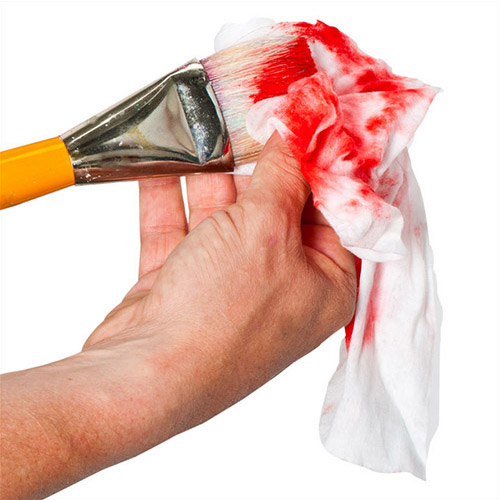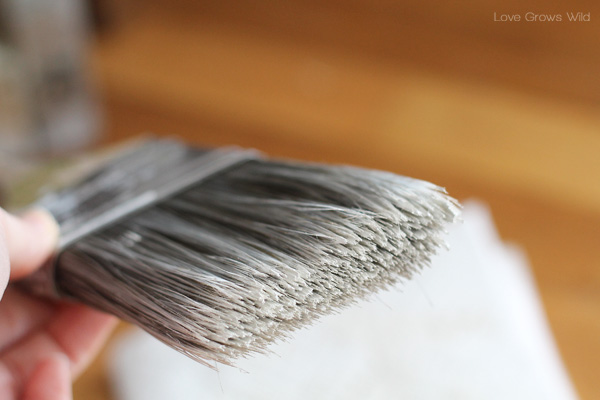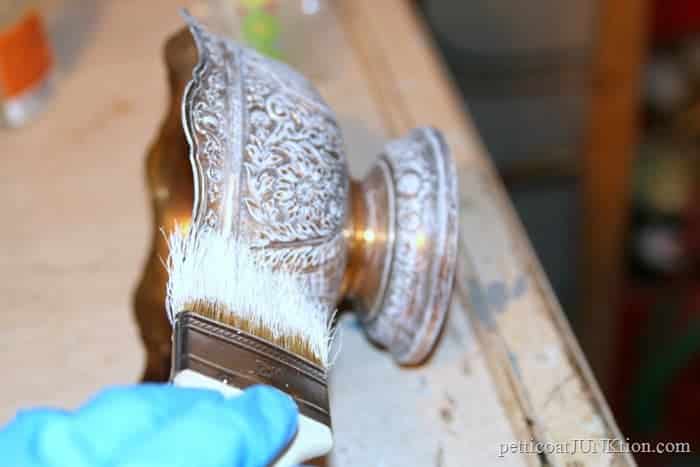Haven't any of you had any professional training at all?
I don't want to steal your thunder Kelly, but this is not Best Practice.
This video gives you step by step instruction for removing dried oil paint from your brushes allowing you restore unusable brushes to like new. Royal Paint Brush has an extensive line of artist paint brushes and artist brush sets. Whether you paint with oils, acrylics, watercolors, etc. You will find the right brush for you at the right price here at Artist Paint Brush. Royal paint brush offers high quality artist brushes at affordable prices and with our Incredible Discounts and Sale. If the dried paint is oil-based, begin this step by pouring turpentine onto the stained bristles. Alternatively, if the dried paint is water-based, you'll need to rinse your brush beneath a faucet. When using a faucet to rinse the brush, make sure the water temperature is lukewarm. If the water is too hot, some of your brush's bristles are liable to fall off. Once your paint brush has been thoroughly rinsed, you'll be ready.

Don't ever put paint thinner into plastic. It will melt most kinds. Why risk a mistake? Old glass salsa jars exist for brush cleaning. label one, put some glass marbles like the flower arranging ones into the bottom to work the brush against. (Plain, not coated with shiny stuff. It'll dissolve) Trying to clean oil based paints out of brushes by just stirring them around doesn't work. If you're desperate a crumpled piece of window screen will work too but it's hard on bristles so this is not a default. Paint thinner is very flammable and an ugly toxin so you want to keep it stingy and the stuff needs to go to Hazardous Waste Disposal. Wipe those brushes really well!
If you're doing fine arts painting go buy a proper brush cleaning pot. A big size one would be good for pro house painters. Solvent sits in it for weeks and it has a sieve to work the bristles over. Paint solids drop below it. The top keeps fumes in and evaporation almost nill over weeks. Minimal exposure, clean brushes. Now wash them! I wash up to thirty brushes a day in the studio; it's just doing the dishes.
Do NOT use a surfactant/ detergent 'soap'. Use a real soap, a chemically designated soap, with oil or fat in it. You can put it on a cellulose sponge and work the brushes across it to work up a lather, or just work them against your palm. If you use bar soap swipe the brushes across it. The soap cuts the oil, and the fat base conditions the bristles.If you wiped out the paint and rinsed in thinner properly there's very little to wash out. More like a post gym shower then wrestling gunk. You don't want paint in a sink drain or on the back patio. Rinse well. If you do this correctly you'll get to wear brushes out instead of throwing them away. And bristles are chosen for this exposure so they'll get better. It's just like washing your hair. Squeeze out the water and shape them, air dry.

This works for synthetic brushes too. Do not leave soap in the bristles as it will contaminate your paint next time and make a bad paint film. As for exotic paints like epoxy? Yes, use nitrile gloves and a respirator! Outside. But if the stuff is hydrocarbon based a fat soap should work too. Acetone on brushes will kill them fast, so make sure thats a really Best Practice. Again- a soap may work better. Most bristles need the conditioning.
If your brushes start to get that gunky icky feeling, soaking them in that inexpensive liquid oil soap from the grocery store (Also best for regular washing after painting) is like a spa treatment. Leave them in for two or three days. It's magic! Paint in the ferules is a ruined brush, but as regular maintenance this is amazing. I have ten year old mongoose thats still sweet. I also paint a lot.

Do not use soap on watercolor brushes. Just rinse.
This is the method professional painters use; It keeps solvent use to an absolute minimum. Reusing a cup or 12 ounces of thinner instead of blowing through gallons of it reduces exposure and that stuff has lead in it. Among other scary things. Don't use it on skin either. Paint'll fall of in 48 hours if soap or olive oil doesn't get rid of it.
Even if you use a thinner only system like the guys who paint cars using industrial paints, a cleaning pot will use less thinner and reduce your chemical exposure. They can be used in series. You can eyeball them at the big online art supply stores, and I shop at industrial supply so don't think they don't interchange. ;-D I'll try to post instructions for the homemade version.
Found a splotch on a favorite garment? Never fear! Here are the right removal methods, no matter whether the accident was oil-, acrylic- or water-based.
Photo: istockphoto.com
It’s bound to happen. You’re just going to do a bit of touch-up or you accidentally brush up against a still-wet project. Next thing you know, there’s paint on your clothes. Don’t panic!
First, find out if the offender is latex, acrylic, or oil. To test, apply rubbing alcohol to a clean white rag and dab the stain: If paint appears on the rag, it’s latex. If not, you’ll need help from a paint removal agent.
While delicate fabrics like silk don’t always fare well in the paint removal process, denim and other cottons often turn out as good as new. So try these treatments, and you might be able to wear that paint-besmirched shirt on your next night out of the house!
Photo: istockphoto.com
Chalk Paint Dried On Brush
Removing Latex Paint from Clothes
Step 1
Act fast if paint is still wet! Place a pad of clean rags or paper towels directly under the paint to keep it from transferring to another area of the garment. Then, scoop off wet paint with a spoon or butter knife, rinse under warm running water, and blot carefully with a clean, dry rag or paper towels. (If you can’t peel your clothes off just then, get rid of the excess as best as you can and wet the area with water until you can take off the garment.) Turn inside out and run warm water through from the back.
Step 2
Liquid dish detergent is great against paint, as long as the garment is color-safe. (Test an inconspicuous area like an inseam by rubbing in detergent and rinsing it. If the item isn’t color safe, use liquid laundry detergent.) Apply detergent directly to the stain and work up a lather with a clean sponge or cloth. Continue hand-washing the area with clean sections of cloth, and move the padding underneath occasionally as well.
Blot to check your progress, and repeat as needed. Then launder as usual. If the paint had dried and remains steadfast despite your efforts with detergent, allow the fabric to dry and proceed to the next step.
Step 3
Again, gently scrape off the now-dried excess with a butter knife. Or firmly press a piece of packing or duct tape onto the paint, then lift it off, repeating until no more comes off.
If the paint residue remains on color-fast fabric (see Step 2), you have one more option: Apply a small amount of rubbing or denatured alcohol (or as a last resort, nail polish remover) to the stain, and work at it with an old toothbrush. Blot with water and repeat as required, then launder as usual.
Photo: istockphoto.com
Removing Oil and Acrylic Paint from Clothes

You’ll be working with chemicals, so be sure to do so in a well-ventilated spot.
Step 1

Scoop off excess wet paint with a spoon or butter knife. If the paint has dried, use the butter knife to scrape off as much as you can. Turn the garment inside out and place a pad of cloth or paper towels under the stained area to aid in blotting.
Dried Paint On Paint Brush
Step 2
Pour a paint removal agent such as a paint thinner or turpentine into a small plastic container—ideally something disposable, like a yogurt tub, for easy cleanup. Soak cotton balls or a clean rag in the paint remover and dab at the stain. Switch out for fresh cotton balls or an unused section of the rag as they pick up paint, moving the pad underneath occasionally, too, for a clean blotting surface.
For a truly stubborn stain, pour a bit of removal agent directly on it and scrub gently with a toothbrush, front and back, to free the fibers of paint.
Step 3
By now, the garment should be practically stain-free. Place a fresh dry cloth or paper towel pad behind the area and blot to absorb the removal agent.
Step 4
Dried Paint Removal
Heeding the label’s recommended laundry detergent, apply a bit of detergent directly to the area and lightly rub it in as a final spot treatment. Wash and dry as usual, and wear the garment proudly. Whether or not you chose to disclose its former paint stain is up to you!
